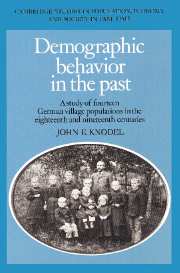 Demographic Behavior in the Past
Demographic Behavior in the Past Published online by Cambridge University Press: 04 August 2010
Most historical investigations of nuptiality in western Europe have focused on the relatively late entry into first marriage for both sexes and the substantial proportions never married that were typical in the past. Far less attention has been paid to the patterns of marital dissolution and remarriage that were characteristic of the prevailing socio-economic and demographic systems, despite their potential significance for the individuals and societies involved.
The studies of historical patterns and trends of remarriage in Europe that have been done are usually based on data on the distribution of marriages according to the marriage order of the spouses. Results have typically revealed a substantial decline in the proportionate share of marriages involving people remarrying, and a concomitant growth in the proportion of primary marriages (those between never-married men and women). In their analysis of English trends, for example, Schofield and Wrigley argue that while 25–30 percent of those marrying in the sixteenth century were remarrying, this proportion had declined to only 10 percent by the nineteenth century. Data from local family reconstitution studies in France, including those by Cabourdin and Bideau, confirm the existence of a trend, from the sixteenth to the nineteenth century, toward a decreasing proportion of remarriages.
There has been considerably less work done on the actual probabilities and rates of remarriage. In their history of the European family, Mitterauer and Sieder assume that the probability of remarriage underwent a ‘continuous’ decline over the last two centuries, although they provide no supporting evidence.
To save this book to your Kindle, first ensure [email protected] is added to your Approved Personal Document E-mail List under your Personal Document Settings on the Manage Your Content and Devices page of your Amazon account. Then enter the ‘name’ part of your Kindle email address below. Find out more about saving to your Kindle.
Note you can select to save to either the @free.kindle.com or @kindle.com variations. ‘@free.kindle.com’ emails are free but can only be saved to your device when it is connected to wi-fi. ‘@kindle.com’ emails can be delivered even when you are not connected to wi-fi, but note that service fees apply.
Find out more about the Kindle Personal Document Service.
To save content items to your account, please confirm that you agree to abide by our usage policies. If this is the first time you use this feature, you will be asked to authorise Cambridge Core to connect with your account. Find out more about saving content to Dropbox.
To save content items to your account, please confirm that you agree to abide by our usage policies. If this is the first time you use this feature, you will be asked to authorise Cambridge Core to connect with your account. Find out more about saving content to Google Drive.